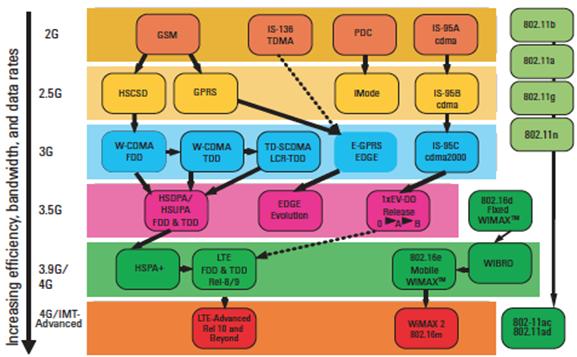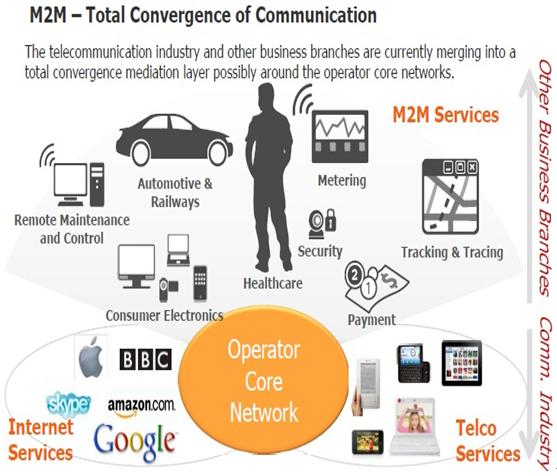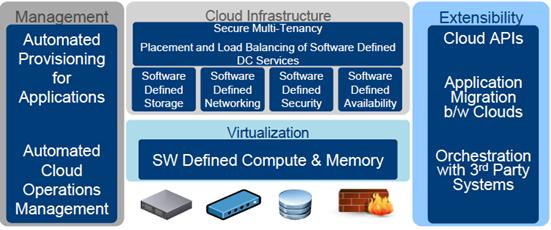Application and Development of IoT in the Mobile Broadband Era (1st)
Author/Boyuan, Su [Issue Date: 2014/8/26]
At the end of 2013, Taiwan finished the release bid of 4G LTE and by the second half of 2014 each qualified telecom operator had begun small regional Service operation.
Now is really the Mobile Broadband Era because in part of the Mobile Internet's move to the mainstream in the past few years. Domestically this is based on WCDMA and HSDPA, and this like. It's what we 3G wireless Internet mode with the accessible down-link bandwidth having a theoretical value range from 2 to 10Mbps based on physical theory. The rate will of course in practical applications be much lower due to various factors. This is still quite a limiting factor in practical applications, such as wireless high-speed mobile data links access and bandwidth during times when crowds of people gather and so on. There has been much discussion of 4G, mostly in terms of LTE (Long-Term Evolution), but in fact, to be exact most of the world's global LTE network is already operating based on earlier versions of industry standards presently defined and this provide only between 3.9G to 4G, however, a true 4G that is now recognized as the industry standard is called LTE-Advanced. LTE-Advanced for fixed or low-speed mobile access networks can provide 1Gbps of theoretical down-link bandwidth and 100Mbps high-speed mobile bandwidth. It's 10 times faster than 3G Mobile Internet that we have been using in the past few years. The following chart comprehensively illustrates the evolution and development of mobile communication technology and the mainstream technology. At present, domestically the trend is determined by GSM down to LTE/LTE-A mobile broadband standards.

Picture 1: Mobile Communication Technology Development (Data Source: Agilent Technologies)
There's been explosive global growth of smart mobile devices in recent years, including in Taiwan. As early as several years ago, Taiwan entered the high penetration level for mobile Internet, but the related applications which promoted the mobile internet growth by a high speed, mainly include OTT (Over the Top — this refers to using the Internet borderless power and telecom operator infrastructure and easily attract large numbers of users to the market and this pull creates economic benefits yet consumes a large amount of resources of the built infrastructure by telecom operators. The service industry who uses the the Internet service does so without different rates ) and Internet Content Providers to dominate consumer industry applications, such as Youtube、 Line、 Facebook、Appstore, and so on. The commercial value and income streams are generated by the online App via purchases by the community of users or by push advertising provided by content providers. This resulted in mobile Internet applications which create the vast majority of economic benefits for a very small group of winners, mostly the device vendor but the telecom service providers who provide the basic infrastructure and lack brand value have quickly become marginalized in the mobile Internet era. Their value and profitability are now meager and cannot continue much longer in this way, in addition to the constantly falling price of fixed mobile Internet rates, this is adding to missing innovation, poor diversification and a profitable new business model is needed.
Even with 4G construction now in full swing, if our thinking about business innovation doesn't create a new idea, then even additional huge investment cannot reverse the current decline in the domestic related industry chain. The value of mobile broadband Internet will rapidly depreciate due to market saturation and the number of users in competition for it, the mobile device industry related ecosystem are not because broadband era coming then can be able to enter a new expanded market, it can be expected that, it will immediately enter the grave yard and with anemic profits. Operation of 4G, with only eyes on the technical side means already heavily degraded market. This will not be able to get us out of today's unhealthy commercial down-turn.
Start of 4GLTE operation does not represent or even open a bright new world for the mobile broadband businesses and the domestic economic development . Given that, how can we trigger the development of related applications, build more and better use of community and extend to the whole environment of different level, that’s a chance for mobile broadband serve as a new train for innovative application business opportunities. Science and technology in the Executive Yuan office will work with the relevant departments to plan the 「accelerate mobile broadband services and industrial development plan」, The primary goal is leading innovation of 4G content service application, and make it as the strategic direction for the future development of 5G, improving the quality of society, avoiding construction and investment without effective planning and benefit goals. In terms of the development of the new service, according to the grants and cooperation means of this plan,it shall promote the improvement of the mobile broadband industry chain, including safety and health, smart business, the life recreational and other areas of innovative applications to achieve wisdom city building, improving the overall convenience of life. Which in addition to the development and application of emerging technology, the generation of high value innovation is necessary for cross-border talent creation and promotion of the commercialization of, for example, social and human expertise, the foundation of cultural and Creative Arts, the depth of the human resource economy, integrated marketing and professional curators ability and so on which are too numerous to enumerate. Relevant personnel of cross-border integration and develop will also be an input to enhance the economic strength of innovation.

Picture 2: IOT Application range through telecommunications cable wireless networks Borderless (data source:openMTC.org)
The Executive Yuan Planning Assessment, such as mobile broadband long-term care plan, smart transportation services, smart park services platform, 4G experience, etc., directly improve peoples daily lives and convenience, reducing the difficulty of traffic jams in rural or city environments, the lack of medical personnel and emergency care facilities, through tele-medicine to medical diagnosis, to improve the quality of emergency treatment and accelerate the first response time to increase the survival rate and reduce the more sequelae, in the promotion of industrial upgrading and business development, the supply chain, logistics, income stream, track record of the original material, efficiency of the transportation system, and the optimization of energy consumption, etc. Given our experience, all of these will in combination with the mobile broadband Internet significantly increased the overall operational efficiency and transparency/safety. In terms of experience, combined with the Internet of Things and mobile broadband, the coupling interaction of businesses and crowds will become more refined, with more precision and personalized marketing, navigation, content broadcast, to create the experience economy providing a great feeling — the desire and meet up for consumption. The high quality of service and process through the teleology and media translates into an excellent consumer culture and strong ecosystem, encouraging more companies to enhance their consumer quality in terms of their commercial activity. Nurturing high quality of cross-border talent is needed to enhance our domestic capability, and then we can best affect the majority of consumers. Let Taiwan the added value which used to legislative power in the past is lower today, can have a more profound connotation of inject to beyond the shallow dish shallow of the short-sighted economic cultural pattern.

Picture 3: Mobile broadband business model application(data source: Science and Technology Yipin,Lin parliamentary secretary” look at the development prospect of telecom services from the trend of the IoT”)
When the IoT arrives at a fast-developed stage through the mobile broadband applications, the transmitted data frequency and coverage path will reach a far higher than the current level of the Internet application , both machine-to-machine and human-to-machine. This is different from the current network architecture and data centers. This will be high diversity data and high - density data applications will be needed to cope with the innovative technology to come. It is possible to provide more intelligent mechanisms and faster more elastic expansion of the infrastructure construction to solve the problems of high demand for processing speed and response time for the explosive requirements of data applications. Concerning cloud computing over the past few years, more advanced evolution is needed, and specifically talk about future technology has centered around four major areas that will accompany the development of mobile broadband Internet applications and these are: SON (Self-Organizing Networks) , SDN (Software-Defined Networks), SDDC (Software-Defined Data Centers), and Big Data.
Conceptually, software-defined data centers or virtual data centers completely virtualize the IT resource to achieve high elasticity, high availability, fast on-line service, and high efficiency of deployment and streamline the planning of human resources. Along with the rise of cloud popularity in recent years we are confronted by the issue of having an enterprise operation of the IT cloud system environment or using vendors, basically virtualization and the degree of automation have been gradually improving, but the maturity and development of network virtualization is far less than the where we now stand with that of servers and storage devices. The Overlay Network Virtualization which is dominated by VMware and is used in data center networks, has improved sufficiently over the past two years , but also suffered in the business environment given its actual effectiveness and the challenges and limitations of the platform. Several major American academic institutions, major investment banks, network service providers, and hardware manufacturers, are pushing Openflow SDN and NFV (Network Function Virtualization), and other market development and the formulation of industry standards. This effort is still subject to tremendous technical restrictions and lack of industrial traction and maturity of the platform. Particularly in commercial operation these technologies are still in their early embryonic development and mostly in small scale experimental stages, in use in places only where there is sufficient internal known-how and willingness to invest large sums of money for innovative plans. This is rarely taken on by telecoms or cloud providers and large manufacturers are in a wait-and-see mode. This behavior speaks to to the market for "hot tech," especially here in Taiwan. Both on the supply side and demand side, the most difficult challenge is overcoming weak software. Strong hardware and network professionals are available but are unable to cross into software development, meanwhile, those skilled in software development cannot overcome their lack of underlying network operation know-how. The result, in the short-term, is failure to keep pace and relinquishing software autonomy to whatever software dominates as defined in other parts of the world.

Picture 4: Software Defined Data Center Element Image (data source: VMware)
Regardless, cloud computing will be the ultimate resource pool ideal for an open, simple and borderless configuration with a highly automated architecture. This is a clear indication of the evolution and development of information technology in various field. In the next five years there will be a paradigm shift of the whole IT deployment and operation method, but the so-called software defined technology model isn't necessarily going along this same track. This may have disruptive innovation disruption as businesses look for ways to implementation and begin utilizing cheaper and lower-skilled employees to achieve their goals. This is the process of evolution and the assumption is that it will likely occur as a worldwide trend. The entire industry and its current business model will be structurally transformed, as well as many people's livelihoods as the need for new expertise emerges.
